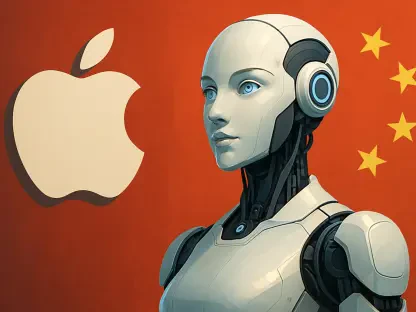In an era where technology dictates the pace of business innovation, a surprising shift is unfolding in corporate environments: Apple, once considered a niche player in enterprise settings, is rapidly becoming a dominant force. This transformation is not just about swapping out devices; it represents a profound rethinking of how workplaces operate amid digital transformation. With employee expectations evolving toward seamless, intuitive technology experiences, Apple’s rise signals a broader movement in how companies prioritize user satisfaction alongside operational goals. This analysis delves into the drivers fueling Apple’s adoption in enterprises, examines real-world examples of this shift, incorporates expert perspectives, explores future implications, and distills key takeaways for businesses navigating this trend.
The Surge of Apple in Corporate Settings
Growth Metrics and Adoption Patterns
Apple’s presence in enterprise environments has seen remarkable growth, with data underscoring a significant pivot away from traditional systems. According to recent Forrester Research reports, a growing number of businesses are integrating Apple devices, particularly Macs, into their ecosystems, with some studies indicating that over 20% of large enterprises now deploy Apple products as primary tools. This upward trajectory, tracked from the current year onward, shows a consistent increase in adoption as companies reassess their IT strategies.
Several factors catalyze this shift, including dissatisfaction with Microsoft’s Windows 11 rollout challenges and high-profile security incidents like the CrowdStrike outage. Such events have prompted IT departments to seek alternatives that promise greater stability and security. Apple’s ecosystem, known for robust encryption and fewer vulnerability exploits, has emerged as a compelling option for organizations aiming to safeguard sensitive data while streamlining operations.
This trend is not merely statistical but reflects a deeper cultural change within enterprises. As businesses prioritize employee-driven technology choices, the demand for Apple devices—often favored for their design and functionality—has surged, pushing companies to rethink long-standing dependencies on Windows-based systems.
Real-World Examples Fueling the Transition
One standout case of this transformation is Autotrader, a leading UK automotive marketplace, which has fully transitioned from a Windows-dominated setup to a 100% Mac fleet. The motivation behind this shift lies in enhancing user experience and operational efficiency, with internal surveys revealing that a significant majority of staff preferred Macs for their intuitive interface and reliability. This move has enabled Autotrader to empower its workforce with tools that align with personal tech preferences, fostering greater engagement.
Beyond Autotrader, other prominent enterprises such as Cisco, IBM, and PayPal have embraced Apple products across sectors like technology, retail, and banking. These organizations cite specific advantages, including Autotrader’s experience with Apple Silicon—namely the M-series processors—that has bolstered development capabilities for multi-platform applications. Additionally, reduced software licensing costs and enhanced security features have proven to be tangible benefits for these companies.
The impact of such transitions extends to strategic IT planning. For instance, Autotrader’s focus on hiring specialized roles like a Senior Mac Engineer highlights a commitment to optimizing the Apple ecosystem rather than merely troubleshooting issues. This proactive approach illustrates how enterprises are redefining technology management to prioritize enablement over traditional support functions.
Industry Voices on Apple’s Corporate Influence
Insights from IT leaders reveal a consensus on why Apple’s ecosystem is gaining traction in business settings. Many emphasize the inherent security features of macOS, which reduce the risk of breaches compared to other platforms, alongside a noticeable decline in support tickets due to the system’s stability. This reduction in IT overhead allows teams to focus on innovation rather than maintenance, a point frequently raised by industry analysts.
Productivity gains also feature prominently in expert discussions. Employees familiar with Apple devices from personal use often adapt quickly in professional contexts, minimizing training time and boosting efficiency. However, challenges persist, such as the need for specialized expertise to integrate Apple systems with existing enterprise software, a hurdle acknowledged by IT managers who stress the importance of strategic hiring to bridge this gap.
A balanced perspective emerges when considering scalability and cost. While the initial investment in Apple hardware can be higher, long-term savings on licensing and support often offset these expenses. Industry voices suggest that as more businesses witness these advantages, the momentum toward Apple adoption is likely to accelerate, reshaping corporate IT norms in the process.
Projecting Apple’s Role in Business Tomorrow
Looking ahead, Apple’s foothold in enterprises appears poised for expansion, driven by continuous innovations in hardware like the M-series chips and a tightly integrated software ecosystem. These advancements promise even greater performance and energy efficiency, appealing to organizations focused on sustainability and cutting-edge technology. The potential for Apple to redefine workplace tools through such developments remains a key area of interest.
Benefits could extend beyond technical upgrades to include stronger employee engagement, as access to preferred devices often correlates with higher job satisfaction. Yet, challenges such as integration costs and compatibility with legacy systems may temper this growth, requiring businesses to allocate resources for seamless transitions. Addressing these hurdles will be critical for sustained adoption across diverse industries.
The broader implications of this trend suggest a reimagining of IT strategies. Apple’s emphasis on user experience could push enterprises to prioritize intuitive design in technology deployments, influencing sectors from finance to manufacturing. As this focus on end-user satisfaction gains prominence, it may set new benchmarks for how businesses approach digital transformation in the long term.
Reflecting on a Transformative Shift
Looking back, the journey of Apple’s integration into enterprise environments stood out as a pivotal moment in reshaping workplace technology. The core drivers—ranging from employee preference to operational efficiencies like enhanced security and reduced costs—marked a departure from conventional IT frameworks. This trend underscored a critical alignment between business strategies and digital tools that empowered workforces.
As businesses reflected on this evolution, the importance of evaluating Apple solutions as a strategic investment became evident. A key next step involved conducting thorough assessments of current IT infrastructures to identify areas where Apple’s ecosystem could deliver value. By prioritizing adaptability and user-centric design, companies positioned themselves to navigate future technological shifts with confidence, ensuring they remained competitive in an ever-changing landscape.









